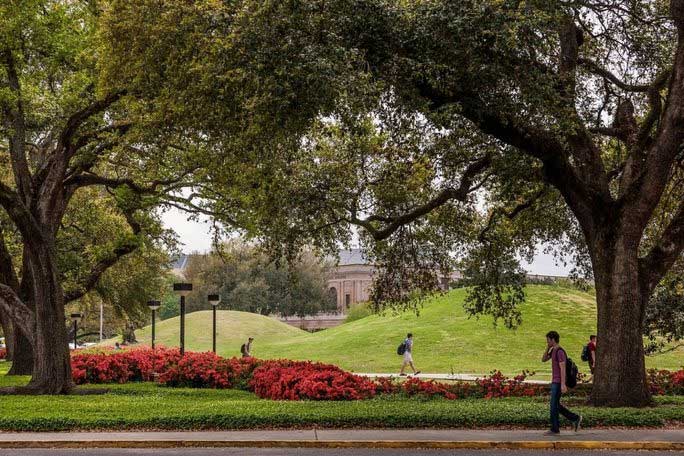The earth mounds located within the campus of Louisiana State University (LSU) in the United States have been identified as a structure that is 11,000 years old, representing a form of mysterious ritual, containing reeds, cane, and unidentified burnt bones.
According to Heritage Daily, this discovery indicates that the hills on the LSU campus are the oldest known man-made structures in North America.
Similar mounds may be widespread across the country but have been destroyed over the centuries. However, the mounds at LSU remain intact, appearing amidst the campus like small green hills covered in grass, nestled in a lush landscape.

The hills on the university campus in the US are actually ceremonial mounds from prehistoric times – (Photo: LSU)
Researchers at the university decided to collect sediment core samples to investigate what these strange hills were made of and discovered that inside, there were not only layers of soil but also numerous layers of ash from burnt reeds and cane.
Even more chilling, there were traces of ancient burnt bones, suggesting that these mounds may have been used by ancient peoples for ritual purposes. However, whether the bones belonged to humans or animals, and which species, remains a puzzle, as the charred fragments have been severely damaged.
Radiocarbon dating indicates that the oldest mound, Mound B, at LSU dates back to 11,000 years ago.
Roots found within the sediment layers suggest that Mound B and possibly the surrounding area were abandoned around 8,200 years ago, coinciding with a significant climate event that caused average temperatures to drop by 1.67 degrees Celsius over a span of 160 years.
Subsequently, around 7,500 years ago, a new mound – Mound A – was constructed by the inhabitants nearby, tilted toward the north. This mound was used until about 6,000 years ago.
Notably, the tops of the two mounds align in a straight line with the giant red star Arcturus, which, around 6,000 years ago, rose approximately 8.5 degrees to the northeast in the night sky. At that time, it was one of the brightest stars visible from Earth.
The preliminary study has just been published in the American Journal of Science, but the LSU team will continue to analyze and investigate to determine which population constructed the mounds and the deeper meanings behind their construction, as well as what types of rituals were conducted.


















































